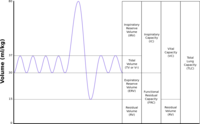
Photo from wikipedia
BACKGROUND Expiratory muscle weakness and impaired airway clearance are early signs of respiratory dysfunction in Duchenne muscular dystrophy (DMD), a degenerative muscle disorder in which muscle cells are damaged and… Click to show full abstract
BACKGROUND Expiratory muscle weakness and impaired airway clearance are early signs of respiratory dysfunction in Duchenne muscular dystrophy (DMD), a degenerative muscle disorder in which muscle cells are damaged and replaced by fibrofatty tissue. Little is known about expiratory muscle pathology and its relationship to cough and airway clearance capacity; however, the level of muscle replacement by fat can be estimated using magnetic resonance imaging (MRI) and expressed as a fat fraction (FF). RESEARCH QUESTION How does abdominal expiratory muscle fatty infiltration change over time in DMD and relate to clinical expiratory function? STUDY DESIGN AND METHODS Individuals with DMD underwent longitudinal MRI of the abdomen to determine FF in the internal oblique, external oblique, and rectus abdominis expiratory muscles. FF data were used to estimate a model of expiratory muscle degeneration using nonlinear mixed effects and a cumulative distribution function. Forced vital capacity, maximal inspiratory and expiratory pressure, and peak cough flow were collected as clinical correlates to MRI. RESULTS Forty individuals with DMD (6-18 years at baseline) participated in up to five visits over 36 months. Modeling estimated the internal oblique progresses most quickly and reaches 50% replacement by fat at a mean age of 13.0 years (external oblique=14.0 years, rectus abdominis=16.2 years). Corticosteroid untreated individuals (N=4) reached 50% muscle replacement by fat 3-4 years prior to treated individuals. Individuals with mild clinical dystrophic phenotypes (N=3) reached 50% muscle replacement by fat 4-5 years later than corticosteroid treated individuals. Internal and external oblique FFs near 50% were associated with maximal expiratory pressures <60cm H2O and peak cough flows <270 L/min. INTERPRETATION These data improve understanding of the early phase of respiratory compromise in DMD, which typically presents as airway clearance dysfunction prior to the onset of hypoventilation, and links expiratory muscle fatty infiltration to pulmonary function measures.
Journal Title: Chest
Year Published: 2021
Link to full text (if available)
Share on Social Media: Sign Up to like & get
recommendations!